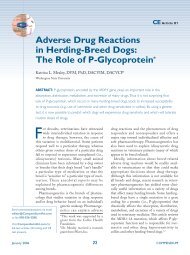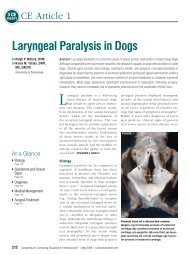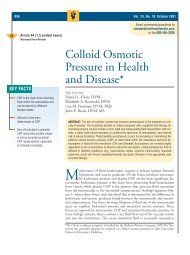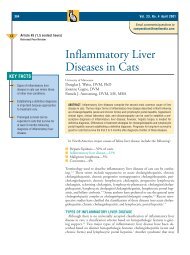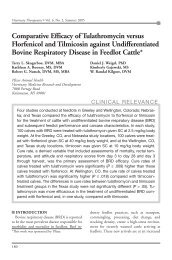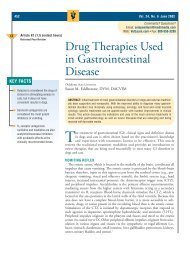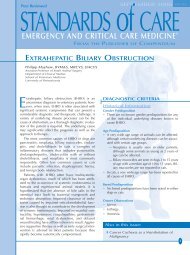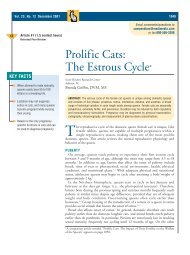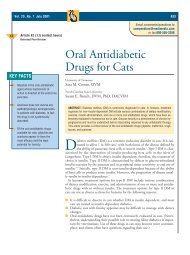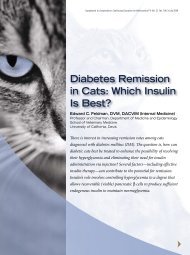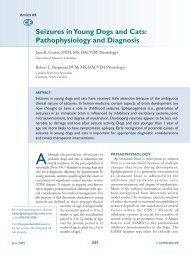CE - VetLearn.com
CE - VetLearn.com
CE - VetLearn.com
You also want an ePaper? Increase the reach of your titles
YUMPU automatically turns print PDFs into web optimized ePapers that Google loves.
Hypothyroidism and<br />
Myxedema Coma<br />
Kevin Finora, DVM, DACVIM (Internal Medicine)*<br />
Deborah Greco, DVM, PhD, DACVIM (Internal Medicine)<br />
The Animal Medical Center<br />
New York, New York<br />
Send <strong>com</strong>ments/questions via email to<br />
editor@CompendiumVet.<strong>com</strong><br />
or fax 800-556-3288.<br />
Visit CompendiumVet.<strong>com</strong> for<br />
full-text articles, <strong>CE</strong> testing, and <strong>CE</strong><br />
test answers.<br />
ABSTRACT: Hypothyroidism is a <strong>com</strong>mon endocrinopathy in dogs but is rare in cats. Lymphocytic<br />
thyroiditis and idiopathic thyroid atrophy are <strong>com</strong>mon causes of this condition. Specific thyroid<br />
function tests, in conjunction with clinical signs and physical examination findings, are used to help<br />
confirm a diagnosis of hypothyroidism.This disease can be managed with synthetic hormone<br />
supplementation and has an excellent prognosis. Myxedema <strong>com</strong>a is a rare and potentially fatal<br />
manifestation of severe hypothyroidism that can be successfully treated using intravenous<br />
levothyroxine.<br />
ypothyroidism is a frequently diagnosed<br />
endocrinopathy in dogs1,2 but a rare phenomenon<br />
in cats. 1 H<br />
The thyroid, under<br />
the influence of thyrotropin (thyroid-stimulating<br />
hormone [TSH]), produces the hormones thyroxine<br />
(T4) and 3,5,3'-triiodothyronine (T3). T4 and T3 have many effects on cellular metabolism,<br />
and their levels in the body are tightly regulated.<br />
Dysregulation of T3 and T4 levels has<br />
far-reaching effects. The signs of thyroid hormone<br />
deficiency are vague, nonspecific, and not<br />
pathognomonic. No single test can be conducted<br />
to make a definitive diagnosis. Instead, a diagnosis<br />
of hypothyroidism is made based on a <strong>com</strong>bination<br />
of clinical signs, physical examination<br />
findings, biochemical abnormalities, and thyroid<br />
function tests. With this <strong>com</strong>bination of tests, a<br />
diagnosis of hypothyroidism<br />
can be made with confidence.<br />
However, clinicians must keep<br />
*Dr. Finora is now affiliated with<br />
The Veterinary Emergency Clinic<br />
and Referral Centre, Toronto,<br />
Ontario, Canada.<br />
Article #1<br />
in mind that nonthyroidal illness, some medications,<br />
physical activity level, and antithyroglobulin<br />
antibodies can alter the results of thyroid<br />
function tests. Once a diagnosis has been made,<br />
this disease can be easily controlled with thyroid<br />
hormone supplementation. A rare but serious<br />
<strong>com</strong>plication of severe hypothyroidism is myxedema<br />
<strong>com</strong>a.<br />
PHYSIOLOGY<br />
Iodine and tyrosine are the basic substrates<br />
involved in thyroid hormone synthesis (Figure<br />
1). Dietary iodide is actively transported into<br />
thyroid follicular cells and oxidized to iodine by<br />
thyroperoxidase. Iodine then binds to tyrosine<br />
residues on thyroglobulin to form monoiodotyrosine<br />
(MIT) and diiodotyrosine (DIT). Coupling<br />
of MIT and DIT forms both T 3<br />
(MIT–DIT) and T 4 (DIT–DIT), which are<br />
bound to thyroglobulin and stored in colloid.<br />
Under the control of TSH, thyroglobulin<br />
undergoes proteolysis in phagolysosomes,<br />
releasing T 3 and T 4. 3,4 Thyroid hormones are<br />
water-insoluble, and their ability to circulate<br />
January 2007 19 COMPENDIUM<br />
<strong>CE</strong>
Illustration by Felecia Paras<br />
20 <strong>CE</strong><br />
Hypothyroidism and Myxedema Coma<br />
Figure 1. Thyroid hormone synthesis. Iodine is transported<br />
into thyroid follicular cells and oxidized. It binds to tyrosine<br />
residues and forms monoiodotyrosine (MIT) and diiodotyrosine<br />
(DIT). MIT and DIT <strong>com</strong>bine to form T 3 (MIT–DIT) and T 4<br />
(DIT–DIT), which are bound to thyroglobulin (TG) for storage.<br />
Under the influence of thyroid-stimulating hormone (TSH),TG<br />
undergoes proteolysis, and T 3 and T 4 are released.<br />
depends on binding to T 4-binding globulin, T 4-binding<br />
prealbumin, or albumin. Most thyroid hormone (i.e.,<br />
>99%) is protein bound, with the remaining unbound<br />
portion being the metabolically active or “free” form. 3–5<br />
These binding proteins are reservoirs for circulating thyroid<br />
hormone and allow the free hormone level to be<br />
maintained within a very narrow range. T 4 is the main<br />
secretory product of the thyroid. However, T 3 is more<br />
biologically active and is most effective in binding to<br />
and activating the thyroid hormone nuclear receptor.<br />
Once in peripheral tissues, T 4 is deiodinated to T 3<br />
before receptor binding. Most T 3 (i.e., 40% to 60%) is<br />
derived from extrathyroidal deiodination of T 4. 3,4<br />
Figure 2. Production and release of thyroid hormone.<br />
The hypothalamus produces thyrotropin-releasing hormone<br />
(TRH), which stimulates the anterior pituitary to produce TSH,<br />
which then stimulates the thyroid.TRH and TSH production is<br />
down-regulated by circulating thyroid hormones, particularly T 3.<br />
The production and release of thyroid hormones are<br />
controlled by a classic negative feedback mechanism<br />
(Figure 2). The hypothalamic–pituitary–thyroid axis is<br />
responsible for maintaining control of extrathyroidal<br />
hormone levels. The hypothalamus produces thyrotropin-releasing<br />
hormone (TRH), which stimulates<br />
thyrotropes in the anterior pituitary to produce TSH. In<br />
addition to hormone release, TSH stimulates growth of<br />
the thyroid gland. 4 Thyroid hormones, particularly T 3,<br />
provide feedback to the hypothalamus and pituitary to<br />
down-regulate TRH and TSH production.<br />
PATHOPHYSIOLOGY<br />
Hypothyroidism can be classified as acquired or congenital.<br />
Acquired hypothyroidism can be primary, sec-<br />
COMPENDIUM January 2007<br />
Illustration by Felecia Paras
ondary, or tertiary and usually affects adult dogs, with<br />
the average age at diagnosis being 7 years. 2 Primary<br />
hypothyroidism is associated with a defect localized to<br />
the thyroid. With this form of hypothyroidism, the thyroid<br />
tissue has been destroyed or replaced and thus<br />
be<strong>com</strong>es less responsive to TSH. Therefore, T 3 and T 4<br />
levels gradually decline, with a <strong>com</strong>pensatory increase in<br />
TSH (Figure 3).<br />
There are two <strong>com</strong>mon histologic forms of primary<br />
hypothyroidism: The first, lymphocytic thyroiditis, is<br />
thought to be an immune-mediated process and eventually<br />
results in thyroid atrophy. The second, idiopathic<br />
thyroid atrophy, is a separate form of thyroid destruction<br />
that does not demonstrate an inflammatory <strong>com</strong>ponent.<br />
6 Together, these processes account for 95% of<br />
the clinical cases of hypothyroidism in dogs. 7 This is<br />
<strong>com</strong>parable with humans, in which 99% of hypothyroidism<br />
is the result of these mechanisms. 8 In dogs,<br />
lymphocytic thyroiditis and idiopathic thyroid atrophy<br />
each accounts for half of the reported cases. 6,7 Lymphocytic<br />
thyroiditis is characterized by chronic and progressive<br />
lymphocytic infiltration and destruction of the<br />
thyroid. Cytotoxic T cells set up inflammation, leading<br />
to thyrocyte destruction and parenchymal fibrosis. 1,6<br />
This process is gradual and accounts for the slow onset<br />
of clinical signs associated with hypothyroidism. The<br />
immune-mediated process is associated with production<br />
of autoantibodies, predominantly against thyroglobulin.<br />
1,9,10 However, autoantibodies against T 3 and T 4 have<br />
Hypothyroidism and Myxedema Coma <strong>CE</strong> 21<br />
Figure 3. Canine thyroid tissue (magnification ×10). (Courtesy of Serena M. Liu,VMD, MS, DACVP, The Animal Medical Center, New<br />
York, NY)<br />
Normal tissue with colloid-filled follicles. Mild lymphocytic thyroiditis. Infiltration of lymphocytes results in<br />
the destruction of the normal thyroid architecture.<br />
been reported. 11,12 Although T 3 and T 4 are haptens, they<br />
are attached to thyroglobulin, which appears to act as<br />
the antigenic stimulus for antibody production. 11 This<br />
differs from the process in humans, in which the<br />
immune target is thyroperoxidase. 8 Recent vaccination<br />
may cause an elevation in antithyroglobulin antibodies<br />
unassociated with primary hypothyroidism. 13 Autoantibodies<br />
crossreact with T 4 assays. 1,14 This is clinically<br />
important because when autoantibodies are present, the<br />
total serum T 4 level can be elevated into the reference or<br />
hyperthyroid ranges, causing clinicians to miss a diagnosis<br />
of hypothyroidism. 1,15 Idiopathic thyroid atrophy<br />
results in replacement of normal tissue with adipose tissue.<br />
6 Rare causes of primary hypothyroidism include<br />
neoplastic destruction of thyroid tissue, iodine deficiency,<br />
infection, and iatrogenic destruction secondary<br />
to drugs, surgery, or radioiodine treatment. 1,2,16,17<br />
Secondary and tertiary hypothyroidism are rare. 1 In<br />
secondary hypothyroidism, the defect is localized to the<br />
pituitary, and the ability to synthesize and secrete TSH<br />
is impaired. Secondary hypothyroidism may be caused<br />
by pituitary tumors, congenital malformation of the<br />
pituitary, infection, or TSH suppression. 1,2 TSH suppression<br />
can be caused by drugs, hormones, or concurrent<br />
illness. 1,2,18 Tertiary hypothyroidism is hypothalamic<br />
in origin, 8 and production of TRH is either decreased or<br />
nonexistent. Tertiary hypothyroidism has not been<br />
reported in the veterinary literature. 19 Both secondary<br />
and tertiary hypothyroid patients would be expected to<br />
January 2007 COMPENDIUM
22 <strong>CE</strong><br />
Hypothyroidism and Myxedema Coma<br />
Clinical Signs of Canine Hypothyroidism 23<br />
Common (40%–49% of clinical cases)<br />
• Obesity • Alopecia<br />
• Lethargy<br />
Un<strong>com</strong>mon (9%–15% of clinical cases)<br />
• Pyoderma • Dry haircoat<br />
• Bradycardia<br />
Rare (
longed interestrous periods, failure to cycle, decreased<br />
libido, and inappropriate mammary gland development. 1<br />
No data have supported an association between decreased<br />
thyroid hormone levels and reproductive failure in males<br />
or females. 34,35 When reproductive failure is detected,<br />
causes besides hypothyroidism must also be investigated.<br />
Cardiovascular abnormalities, although rare, have<br />
been reported. Cardiovascular signs may be secondary to<br />
problems with conduction or direct myocardial effects.<br />
Bradycardia, arrhythmias, decreased conduction, decreased<br />
contractility, and diastolic dysfunction have been<br />
reported. 23 In the hypothyroid state, there is a decreased<br />
β-adrenergic receptor number, accounting for decreased<br />
contractility and lower heart rates. 36 In contrast to<br />
humans, congestive heart failure has not been documented<br />
secondary to hypothyroidism in dogs. 37<br />
Ocular changes can include corneal cholesterol<br />
deposits, keratoconjunctivitis sicca, and conjunctivitis,<br />
although these signs are reported in less than 1% of all<br />
hypothyroid dogs. 23<br />
Hypercholesterolemia, hypertriglyceridemia, and<br />
hyponatremia are <strong>com</strong>monly noted in serum biochemistry<br />
results 29,38 (see box on this page). These changes are<br />
the result of the decrease in normal lipid metabolism<br />
ac<strong>com</strong>panying hypothyroidism. Hypothyroid dogs have<br />
increased very–low-density lipoproteins, low-density<br />
lipoproteins, and high-density lipoproteins. 39 Increased<br />
triglyceride levels may play a role in the development of<br />
pancreatitis, although this association has not been<br />
proven. Elevated levels of cholesterol and triglycerides<br />
have been associated with atherosclerosis in dogs,<br />
although this is rare. 39,40<br />
Anemia is another <strong>com</strong>mon finding, affecting 28% to<br />
32% of hypothyroid dogs. 31,38 The anemia is usually normochromic,<br />
normocytic and nonregenerative and likely<br />
results from one of or a <strong>com</strong>bination of three mechanisms:<br />
There may be decreased erythropoietin production, a<br />
reduced response of progenitor cells to erythropoietin, or<br />
decreased stimulation of early hematopoietic stem cells. 41<br />
The hypothyroid state does not affect the erythrocyte life<br />
span.<br />
Hypothyroidism and Myxedema Coma <strong>CE</strong> 23<br />
Common Laboratory Findings Associated<br />
with Hypothyroidism<br />
Serum biochemical abnormalities<br />
• Hypercholesterolemia<br />
• Hyperlipidemia<br />
• Hypertriglyceridemia<br />
• Hyponatremia<br />
Complete blood count abnormality<br />
• Nonregenerative anemia (usually normochromic,<br />
normocytic)<br />
THYROID FUNCTION TESTING<br />
The diagnosis of hypothyroidism is <strong>com</strong>plex. The TSH<br />
stimulation test is a reliable single test used to diagnose<br />
hypothyroidism and is considered the gold standard. 42<br />
However, there is limited access to test reagents, and the<br />
cost is often prohibitive. Other tests are available to help<br />
clinicians evaluate thyroid function, thyroid hormone levels,<br />
and antithyroglobulin antibody levels. These tests<br />
include total T 4, endogenous canine TSH, free T 4,<br />
antithyroglobulin antibodies, anti-T 3 antibodies, anti-T 4<br />
antibodies, total T 3, free T 3, and reverse T 3.<br />
Assessment of total thyroxine as a screening test in <strong>com</strong>bination with thyroid-stimulating<br />
hormone assessment as a confirmatory test are appropriate for obtaining a diagnosis of<br />
hypothyroidism. Free thyroxine may be used when initial test results are unclear.<br />
A <strong>com</strong>monly requested initial screen of thyroid function<br />
is the total T 4 level test, which measures both protein-bound<br />
and free T 4 levels. The total T 4 level is a<br />
direct assessment of the functional ability of the thyroid<br />
tissue to produce hormone. A decreased total T 4 level is a<br />
<strong>com</strong>mon finding in hypothyroid animals; however, this is<br />
not diagnostic of hypothyroidism and necessitates more<br />
specific testing to confirm the diagnosis. 43 The total T 4<br />
level can be measured by ELISA, chemiluminescence, or<br />
radioimmunoassay. There is indication that in-house<br />
ELISA is less reliable than radioimmunoassay. 44<br />
Measurement of the endogenous TSH level is available<br />
using a canine assay. Because of crossreactivity, this<br />
assay may also be used in cats. 45 In the hypothyroid<br />
state, the TSH level would be expected to be elevated<br />
due to loss of negative feedback. The TSH level test has<br />
high specificity and low sensitivity. Because total or free<br />
T 4 and TSH levels are both elements of the feedback<br />
January 2007 COMPENDIUM
24 <strong>CE</strong><br />
Hypothyroidism and Myxedema Coma<br />
mechanism of the hypothalamic–pituitary–thyroid axis,<br />
they should be interpreted together. In other words, to<br />
accurately understand the significance of a TSH level,<br />
the clinician must know the total or free T 4 level. Current<br />
methods of assessing TSH levels are not sensitive at<br />
low levels. Therefore, TSH cannot be used in the diagnosis<br />
of secondary hypothyroidism.<br />
The free T 4 level test measures the metabolically active<br />
portion of the total T 4 level. This fraction of the hormone<br />
can enter the cell, be converted into T 3, and interact with<br />
the thyroid hormone receptor. Hypothyroid animals<br />
would be expected to have a low free T 4 level. This test,<br />
like the total T 4 level test, is most valuable as a screening<br />
test. Concurrent illness has less effect on the free T 4 level<br />
<strong>com</strong>pared with the total T 4 level. 43,46 However, glucocorticoids,<br />
phenobarbital, and hyperadrenocorticism have been<br />
noted to decrease the free T 4 level. 47–49 Different methods<br />
can be used to measure the serum free T 4 level. Measurement<br />
by equilibrium dialysis has been demonstrated to be<br />
the most reliable <strong>com</strong>pared with radioimmunoassay. 50<br />
The equilibrium dialysis method also mitigates the influ-<br />
ence of antithyroglobulin antibodies, leading to the best<br />
likelihood of an accurate test result.<br />
Immune-mediated thyroiditis may result in the production<br />
of antithyroglobulin or anti-T 3 or -T 4 antibodies.<br />
It is possible to test for antithyroglobulin antibodies, and<br />
a positive titer is predictive of immune-mediated thyroiditis<br />
1,9,10 and suggestive of hypothyroidism. 51 Anti-T 3<br />
and -T 4 antibodies may create a problem in the diagnosis<br />
of hypothyroidism. The antibodies are similar to those of<br />
T 3 and T 4 and can crossreact to falsely elevate assay levels.<br />
10,15 Therefore, if anti-T 4 antibodies are present, the<br />
total T 4 level will reportedly be higher than it actually is.<br />
This is of most concern with animals in which the total<br />
T 4 level is truly just below the normal range. With the<br />
presence of anti-T 4 antibodies, these animals may actually<br />
appear to be euthyroid, thus delaying diagnosis and<br />
treatment of hypothyroidism. Free T 4 measured by dialysis<br />
is not affected by the presence of antithyroglobulin or<br />
anti-T 3 or -T 4 antibodies. 15 In some situations, the<br />
antithyroglobulin antibodies are positive, but the total<br />
and free T 4 levels are well within normal range, and the<br />
animal does not exhibit clinical signs associated with<br />
hypothyroidism. These cases demand close monitoring<br />
and reevaluation because they may be at risk of developing<br />
hypothyroidism.<br />
For many years, the TSH stimulation test was used to<br />
diagnose hypothyroidism. 52,53 This test was routinely<br />
conducted using pharmaceutical-grade bovine TSH.<br />
With the introduction of re<strong>com</strong>binant human TSH,<br />
production of pharmaceutical-grade bovine TSH was<br />
halted. Studies 54,55 have demonstrated that re<strong>com</strong>binant<br />
human TSH can be used in both dogs and cats safely<br />
and effectively to conduct the TSH stimulation test.<br />
Adverse side effects of re<strong>com</strong>binant human TSH in<br />
humans include headache and nausea; no adverse effects<br />
have been reported in cats or dogs. Re<strong>com</strong>binant human<br />
TSH is very expensive, and although its use is validated,<br />
it is unlikely to be<strong>com</strong>e routine and displace the total<br />
and free T 4 tests and the TSH stimulation test as the<br />
preferred diagnostics.<br />
Serum total T 3 measurement is an unreliable indicator<br />
of thyroid function. The total T 3 level has been demonstrated<br />
to be normal in up to 90% of all hypothyroid<br />
dogs. 46 In case-controlled studies, the reverse T 3 level<br />
Hypothyroidism is a <strong>com</strong>mon endocrinopathy in dogs and has vague clinical signs.<br />
has not been validated in <strong>com</strong>panion animals. Therefore,<br />
evaluation of total T 3, free T 3, and reverse T 3 levels<br />
is not routinely re<strong>com</strong>mended to assess thyroid function<br />
in dogs. 1,43<br />
Another tool has recently be<strong>com</strong>e available to assist in<br />
the diagnosis of hypothyroidism. Two studies 56,57 have<br />
indicated that ultrasonography of the thyroid is helpful in<br />
distinguishing hypothyroid and euthyroid dogs. The<br />
studies demonstrated significant differences in thyroid<br />
volume and echogenicity between hypothyroid and<br />
euthyroid patients. There was no significant difference<br />
between euthyroid and sick euthyroid subjects. These<br />
studies concluded that ultrasonography can be an adjunctive<br />
diagnostic tool to assist in the diagnosis of canine<br />
hypothyroidism. 56,57 Limitations of this test include the<br />
need for high-quality ultrasonography equipment and a<br />
skilled, trained operator. In the future, this test may<br />
be<strong>com</strong>e more widespread and routine.<br />
All available tests can be used to help diagnose<br />
hypothyroidism (Table 1). Investigation of hypothyroidism<br />
should be based on an increased index of suspicion.<br />
A <strong>com</strong>plete blood count, serum biochemistry<br />
profile, and urinalysis are helpful in ruling out the pres-<br />
COMPENDIUM January 2007
Table 1. Available Tests for the Diagnosis of Hypothyroidism<br />
ence of nonthyroidal illness (Figure 4). The next step<br />
would be to run a highly sensitive test (i.e., total T 4<br />
level) for screening and a more specific test (i.e., canine<br />
TSH level) to help confirm the diagnosis (Table 2). In<br />
some instances, a concurrent illness may not be able to<br />
be resolved (e.g., diabetes mellitus, chronic renal failure);<br />
because TSH is minimally affected by concurrent<br />
disease, 53 it is still re<strong>com</strong>mended to proceed with these<br />
tests. The data in Table 2 demonstrate that by using a<br />
<strong>com</strong>bination of tests, clinicians can obtain a highly reliable<br />
result. However, in some situations, test results are<br />
unclear. This occurs with early (subclinical) hypothy-<br />
Hypothyroidism and Myxedema Coma <strong>CE</strong> 25<br />
Test/Tool Measures Affected By Comments Re<strong>com</strong>mended<br />
Total T4 Protein-bound<br />
and free T4 Antithyroglobulin<br />
antibodies may<br />
falsely increase<br />
the result<br />
Low total T4 level<br />
is suggestive<br />
but not diagnostic<br />
Yes<br />
Other illnesses or Radioimmunoassay<br />
drugs may falsely<br />
decrease the result<br />
(box on p. 27)<br />
is preferred<br />
Canine TSH Endogenous — Not sensitive at low Yes, with total and<br />
TSH TSH levels free T4 levels<br />
Free T4 Free T4 Drugs may falsely<br />
decrease results<br />
(box on p. 27)<br />
Hyperadrenocorticism<br />
may falsely decrease<br />
the result<br />
Equilibrium dialysis<br />
method is preferred<br />
Yes, with total T4 or<br />
canine TSH levels<br />
Antithyroglobulin<br />
antibodies<br />
T3 or T4 antibody levels<br />
Presence of<br />
antithyroglobulin<br />
Positive titer is<br />
suggestive of<br />
Yes, as an adjunct<br />
test in dogs with<br />
antibodies may increase hypothyroidism slightly low total<br />
the total T4 level T4 levels<br />
TSH stimulation<br />
test<br />
T4 levels before<br />
and after<br />
— Bovine TSH has<br />
been replaced<br />
It can be considered<br />
but is prohibitively<br />
stimulation by re<strong>com</strong>binant<br />
human TSH<br />
expensive<br />
Total or Protein-bound — Normal in up to 90% No<br />
free T3 and free T3 levels of hypothyroid dogs<br />
Reverse T3 Levels of — Controlled study No<br />
inactive form validation is missing<br />
of T3 in dogs<br />
Ultrasonography Thyroid — Visible differences Yes, as an adjunct<br />
volume and exist between normal<br />
echogenicity or euthyroid and<br />
hypothyroid dogs<br />
roidism, secondary hypothyroidism (sick euthyroid),<br />
anti-T 4 antibodies, or other causes of thyroid hormone<br />
suppression. In these situations, obtaining a free T 4 level<br />
can be a secondary test to help indicate an animal’s thyroid<br />
status. In some instances, early (subclinical) hypothyroidism<br />
or unclear results may be detected; a rational<br />
approach would be to retest the animal in 4 weeks.<br />
OTHER FACTORS THAT ALTER THYROID<br />
FUNCTION TEST RESULTS<br />
Besides sick euthyroid syndrome, additional factors<br />
can alter the results of thyroid function tests, potentially<br />
January 2007 COMPENDIUM
26 <strong>CE</strong><br />
Hypothyroidism and Myxedema Coma<br />
Is it a resolvable nonthyroidal illness?<br />
Yes<br />
Treat illness<br />
Low total T 4<br />
and increased<br />
TSH levels<br />
Hypothyroid;<br />
start treatment<br />
Decreased<br />
TSH level<br />
Secondary hypothyroid<br />
(sick euthyroid)<br />
Figure 4. Diagnosis of hypothyroidism.<br />
Clinical suspicion of hypothyroidism based on clinical<br />
signs, physical examination findings, and history<br />
Is there evidence of nonthyroidal illness?<br />
Yes<br />
Low total T 4<br />
and low<br />
TSH levels<br />
No<br />
Low total T 4<br />
and normal<br />
TSH levels<br />
COMPENDIUM January 2007<br />
No<br />
Conduct initial thyroid tests<br />
(total T 4 and TSH levels)<br />
Conduct secondary thyroid test<br />
(free T 4)<br />
Normal total T 4<br />
and increased<br />
TSH levels<br />
Low free T 4 level Normal free T 4 level<br />
Normal or increased<br />
TSH level<br />
Early<br />
hypothyroid<br />
Normal total T 4<br />
and normal<br />
TSH levels<br />
Euthyroid<br />
If clinical signs<br />
persist, retest in 4 wk
Table 2. Comparison of Canine Thyroid Diagnostic Tests<br />
resulting in misdiagnosis (see box on this page). Most<br />
reported factors cause an artificial decrease in thyroid<br />
hormone levels. Many drugs affect thyroid hormone<br />
levels and may result in an animal developing clinical<br />
signs of hypothyroidism. The exact mechanisms for<br />
each factor are not <strong>com</strong>pletely and individually understood.<br />
However, decreased binding of thyroid hormone<br />
to proteins and the ability of certain drugs to bind<br />
iodine, making it less available for thyroid hormone synthesis,<br />
are two mechanisms explaining how certain<br />
drugs can cause decreased thyroid hormone levels. Sulfonamides,<br />
18,58,59 glucocorticoids, 60,61 phenobarbital, 62,63<br />
clomipramine, 64 and NSAIDs 18,65 have all reportedly<br />
decreased circulating thyroid hormone levels in animals.<br />
Sulfonamides inhibit thyroid peroxidase and decrease<br />
iodine organification and thus production of T 3 and T 4.<br />
This effect is noted to occur within weeks of initiation<br />
of therapy and disappears 2 weeks after therapy has<br />
been discontinued. 59 Glucocorticoids inhibit the entire<br />
hypothalamic–pituitary–thyroid axis and have a direct<br />
effect against thyroid hormone. 18 The effects of phenobarbital<br />
are noted only in animals receiving long-term<br />
treatment. To produce reliable results, clinicians should<br />
not administer phenobarbital to patients for 4 weeks<br />
before thyroid function testing. 18,63 Various studies 18,65<br />
have found the influence of NSAIDs to be variable,<br />
depending on the specific agent used. In animals that<br />
receive any of these medications, evaluation of thyroid<br />
function must be made with caution and preferably after<br />
they have stopped receiving the medications well in<br />
advance.<br />
Another factor well documented to result in lower<br />
thyroid hormone levels is athletic conditioning and<br />
training. Several studies 66–70 have demonstrated that<br />
well-conditioned sled dogs and greyhounds reliably have<br />
lower total and free T 4 levels, which may lead to misdiagnosis<br />
of hypothyroidism. In addition, recent vaccina-<br />
Hypothyroidism and Myxedema Coma <strong>CE</strong> 27<br />
Total T 4 Free T 4 (ED) TSH Total T 4/TSH Free T 4 (ED)/TSH<br />
Study Sensitivity Specificity Sensitivity Specificity Sensitivity Specificity Sensitivity Specificity Sensitivity Specificity<br />
Peterson 89% 82% 98% 93% 76% 93% 67% 98% 74% 98%<br />
et al 46<br />
Dixon and 100% 75.3% 80% 93.5% 86.7% 81.8% 86.7% 92.2% 80% 97.4%<br />
Mooney 47<br />
ED = by equilibrium dialysis.<br />
tion has been demonstrated to cause a transient increase<br />
in circulating autoantibody levels. This may cause a truly<br />
hypothyroid animal to appear euthyroid and may result<br />
in a delay or discontinuation of appropriate therapy.<br />
Thyroid function testing should not be conducted if a<br />
patient has been vaccinated within the previous 2<br />
weeks. 13<br />
TREATMENT AND THERAPEUTIC<br />
MONITORING<br />
Synthetic thyroid hormone supplementation easily<br />
treats hypothyroidism. Levothyroxine sodium is available<br />
as both human and veterinary products. It is re<strong>com</strong>mended<br />
to avoid generic forms of the drug because<br />
human studies have demonstrated wide variability in the<br />
bioavailability of generic forms. 2,71 If a generic form is<br />
used, it is important to always prescribe the same formulation<br />
to an individual patient. Hormone supplementation<br />
is usually initiated at 0.02 mg/kg PO q12h. Thyroid<br />
function testing is re<strong>com</strong>mended 6 weeks after therapy<br />
has begun. The total T 4 level should be monitored and<br />
timed so that blood is taken 6 hours after pill administration.<br />
1,72 In stable, well-controlled animals, the total<br />
treatment may be given once daily with excellent clinical<br />
results, as long as adequate peak hormone concentrations<br />
Factors Affecting Thyroid Function Test<br />
Results<br />
Decreased thyroid hormone levels<br />
• Drugs: sulfonamides, glucocorticoids, phenobarbital,<br />
clomipramine, NSAIDs<br />
• Good conditioning: racing greyhounds, sled dogs<br />
• Other illness<br />
Increased thyroid hormone levels<br />
• Recent vaccination<br />
• Presence of antithyroglobulin antibodies<br />
January 2007 COMPENDIUM
28 <strong>CE</strong><br />
Hypothyroidism and Myxedema Coma<br />
are achieved. 42 In animals that receive supplementation<br />
once daily, blood should be taken immediately before the<br />
medication is given and then again 6 hours later. When<br />
therapy is appropriate, the total T 4 level should be high<br />
normal to high. If the total T 4 level is significantly above<br />
normal, the medication dose should be decreased or the<br />
frequency changed. If the total T 4 level is low, an increase<br />
in the dose may be necessary. Before increasing the dose,<br />
the clinician must assess client <strong>com</strong>pliance, ensure that<br />
no gastrointestinal issues will impact absorption, and<br />
confirm that there has not been a switch in the levothyroxine<br />
formulation. Supplementation levels can be increased<br />
to a maximum of 0.8 mg per dog per treatment.<br />
It should be noted that levothyroxine doses for dogs<br />
exceed those for humans and may confuse pharmacists or<br />
endocrinologists. 71 Thyroid function should be monitored<br />
every 6 to 8 weeks for the first 6 to 8 months of<br />
treatment and then once or twice yearly. 1,72<br />
Evaluation of TSH is a controversial tool to help<br />
assess response to therapy. In a well-controlled animal,<br />
the TSH level would be expected to be in the normal<br />
range. However, there is a report 72 indicating that the<br />
TSH level may be normal in as many as 75% of dogs<br />
requiring an increase in their supplementation levels. An<br />
increased TSH level is a predictable indicator of the<br />
need to increase supplementation levels to achieve ade-<br />
quate hormone control. However, a normal TSH level<br />
alone does not indicate that hormone supplementation<br />
is adequate in all dogs. 72<br />
An important aspect to help assess response to therapy<br />
is the degree to which clinical signs of hypothyroidism<br />
resolve. Marked improvement in the patient’s attitude,<br />
activity level, and alertness should occur within 1 week of<br />
starting therapy. Polyneuropathy usually starts to<br />
improve quickly, but <strong>com</strong>plete resolution may take several<br />
months. 29 The hematocrit count and serum cholesterol<br />
level should gradually resolve in the first weeks of<br />
therapy. 72 Dermatologic abnormalities improve slowly,<br />
with <strong>com</strong>plete resolution usually taking up to 3<br />
months. 1,72 Response to treatment is a valuable tool to<br />
help determine the success of therapy but should not<br />
replace appropriate blood tests. Hypothyroidism can be<br />
easily and successfully controlled, and the prognosis for<br />
affected animals, when appropriately treated, is excellent.<br />
MYXEDEMA COMA<br />
Myxedema <strong>com</strong>a is a rare, life-threatening, extreme<br />
manifestation of severe hypothyroidism and is considered<br />
an endocrine emergency. The mortality rate in<br />
humans ranges from 15% to 60%. 32,73 Myxedema <strong>com</strong>a<br />
is rare in animals, and much of what is known in veterinary<br />
medicine is based on a few case reports 23,74 or is<br />
taken from human medicine. The development of<br />
myxedema <strong>com</strong>a requires a precipitating event that<br />
overwhelms normal homeostatic mechanisms. In<br />
humans, this is often an infection, 32 whereas in animals,<br />
no single event has been repeatedly identified.<br />
The <strong>com</strong>mon findings in patients with myxedema<br />
<strong>com</strong>a are changes in mental status, altered thermoregulation,<br />
and nonpitting skin edema. 8,23,73,74 Mentation<br />
changes can range from altered alertness to <strong>com</strong>a. Coma<br />
does not always occur, and in humans, mental depression<br />
is the most <strong>com</strong>mon assessment of mental status. 32<br />
Edema, localizing in the brain, is responsible for the<br />
development of altered mentation. Hyponatremia can<br />
cause a further decrease in the neurologic status. 32<br />
Patients with myxedema <strong>com</strong>a are often hypothermic<br />
but not shivering. Thyroid hormone has a permissive<br />
Myxedema <strong>com</strong>a is a manifestation of severe hypothyroidism.Affected animals have<br />
altered mentation, are hypothermic without shivering, and have nonpitting edema.<br />
effect on calcium ATPase. In the hypothyroid state, there<br />
is decreased activity of this enzyme, resulting in<br />
decreased ATP use. 73 ATP is the powerhouse of the cell,<br />
and with decreased activity, there is decreased oxygen<br />
consumption and thus decreased heat generation. In<br />
addition, hypothalamic dysfunction, secondary to edema<br />
formation in the brain, may lead to alteration in the<br />
thermoregulatory set-point. 32,73 These changes may result<br />
in a lower body temperature and reduced likelihood to<br />
shiver. Shivering can be stimulated by the hypothalamus<br />
or sympathetic nervous system. T 4 amplifies catecholamine<br />
function, helping to stimulate muscular activity<br />
associated with shivering 74 ; therefore, a reduced T 4<br />
level blunts the ability to shiver. Hypothermia reduces<br />
platelet function, resulting in hepatic platelet sequestration<br />
and decreased enzymatic activity within the coagu-<br />
COMPENDIUM January 2007
lation cascade. 74 With a decreased body temperature,<br />
there is peripheral vasoconstriction and central shunting<br />
of blood. Nonpitting edema of the skin is due to deposition<br />
of glycosaminoglycans in the interstitial space. 1,73<br />
Initial laboratory tests reveal hypercholesterolemia,<br />
hypertriglyceridemia, hypoglycemia, anemia, hyponatremia,<br />
hypoxemia, and hypercarbia. 73,74 Thyroid function<br />
tests indicate severe hypothyroidism with low total<br />
T 4, low free T 4, and elevated TSH levels. 74 After a diagnosis<br />
of myxedema <strong>com</strong>a has been made, immediate<br />
treatment is necessary (see box on this page). This usually<br />
means initiating treatment before thyroid function<br />
test results confirm clinical suspicion of myxedema<br />
<strong>com</strong>a. Initial attention must be paid to the provision of a<br />
patent airway and resuscitation of hypotension.<br />
Mechanical ventilation, which has been described in<br />
humans and dogs, may be necessary. 33,73 The goals of<br />
fluid therapy are to support blood pressure and to<br />
address decreased sodium levels. Clinicians must<br />
remember that patients with myxedema <strong>com</strong>a have a<br />
decreased ability to clear free water. The hallmark of<br />
therapy is intravenous administration of synthetic thyroid<br />
hormone. A levothyroxine dose of 5 µg/kg IV<br />
q12h is most <strong>com</strong>monly described. 1,2,73 A more conservative<br />
replacement dose should be used when there is<br />
concern about cardiac function, especially the heart’s<br />
ability to deal with a sudden and rapid increase in the<br />
metabolic rate. 73,74 Rapid rewarming of patients with<br />
myxedema <strong>com</strong>a must be avoided because this may<br />
result in peripheral vasodilation, hypotension, and<br />
potential cardiovascular collapse. Correction of hypothermia<br />
should be passive and should occur over a<br />
number of hours.<br />
The greatest challenge in treating myxedema <strong>com</strong>a is<br />
recognizing the syndrome. Once it is recognized, immediate<br />
and intensive supportive care is necessary to treat<br />
the patient. Successful treatment has been reported in<br />
dogs and humans 33,74 ; however, mortality rates can be<br />
high. 32<br />
CONCLUSION<br />
Hypothyroidism is a <strong>com</strong>mon endocrine disease in<br />
dogs but is rare in cats. The most <strong>com</strong>mon forms of<br />
hypothyroidism are lymphocytic thyroiditis and idiopathic<br />
thyroid atrophy. The clinical signs of the disease<br />
are vague and can affect many body systems. Evaluation<br />
of the total T 4 level is considered an excellent screening<br />
test. Evaluation of the canine TSH level is a good confirmatory<br />
test and has a specificity of 98% when it is<br />
Hypothyroidism and Myxedema Coma <strong>CE</strong> 29<br />
Treating Myxedema Coma<br />
• Establish an airway.<br />
• Ensure adequate ventilation.<br />
• Administer intravenous fluids: 0.9% sodium chloride<br />
(20 ml/kg [initial bolus]). Reassess and continue<br />
intravenous fluids (2.5–7 ml/kg/hr). Select rate based<br />
on blood pressure, heart rhythm, heart rate, and<br />
respiratory rate.<br />
• Administer levothyroxine at 5 µg/kg (0.005 mg/kg)<br />
IV q12h. a<br />
• Once the animal can swallow, start levothyroxine at<br />
20 µg/kg (0.02 mg/kg) PO q12h. This dose can be<br />
started while still using intravenous levothyroxine to<br />
help achieve therapeutic blood levels. a<br />
• Use passive rewarming (via water blankets or forcedair<br />
devices). Continue until the temperature is low<br />
normal and can be maintained without support.<br />
aThe levothyroxine dose should be decreased by 50%–75% if<br />
there is preexisting heart disease. 73<br />
used in conjunction with evaluation of the total or free<br />
T 4 levels. Several factors may alter the results of thyroid<br />
function testing. The presence of anti-T 4 antibodies can<br />
falsely increase total T 4 levels and mask true hypothyroidism.<br />
Alternatively, many drugs and athletic conditioning,<br />
in some breeds, may decrease total T 4 levels<br />
while not being associated with a true hypothyroid state.<br />
Treatment of hypothyroidism is easily achieved with<br />
levothyroxine supplementation. Success of therapy must<br />
be assessed with close monitoring via thyroid function<br />
testing. With appropriate treatment, hypothyroidism<br />
can be well managed and have an excellent prognosis. A<br />
rare <strong>com</strong>plication of severe hypothyroidism is myxedema<br />
<strong>com</strong>a. This condition is difficult to recognize but<br />
is associated with an altered mental state, hypothermia<br />
without shivering, and nonpitting skin edema. With<br />
aggressive supportive therapy and intravenous thyroid<br />
hormone replacement, this condition may be successfully<br />
treated, although the mortality rate remains high.<br />
REFEREN<strong>CE</strong>S<br />
1. Feldman ED, Nelson RW (eds): Canine and Feline Endocrinology and Reproduction.<br />
St. Louis, Elsevier Saunders, 2004, pp 86–151.<br />
2. Scott-Moncrieff JCR, Guptill-Yoran L: Hypothyroidism, in Ettinger SJ,<br />
Feldman EC (eds): Textbook of Veterinary Internal Medicine. St. Louis, Elsevier<br />
Saunders, 2005, pp 1535–1544.<br />
3. Guyton AC, Hall JE (eds): Textbook of Medical Physiology. St. Louis, Elsevier<br />
Saunders, 2005, pp 858–869.<br />
4. Cunningham JG (ed): Textbook of Veterinary Physiology. New York, WB<br />
Saunders, 2002, pp 341–372.<br />
January 2007 COMPENDIUM
30 <strong>CE</strong><br />
Hypothyroidism and Myxedema Coma<br />
5. Gulikers KP, Panciera DL: Influence of various medications on canine thyroid<br />
function. Compend Contin Educ Pract Vet 24(7):511–521, 2002.<br />
6. Gosselin SJ, Capen CC, Martin SL: Histologic and ultrastructural evaluation<br />
of thyroid lesions associated with hypothyroidism in dogs. Vet Pathol 18(3):<br />
299–309, 1981.<br />
7. Kemppainen RJ, Clark TP: Etiopathogenesis of canine hypothyroidism. Vet<br />
Clin North Am Small Anim Pract 24(3):467–476, 1994.<br />
8. Tews MC, Shah SM, Gossain VV: Hypothyroidism: Mimicker of <strong>com</strong>mon<br />
<strong>com</strong>plaints. Emerg Med Clin North Am 23(3):649–667, 2005.<br />
9. Nachreiner F, Refsal KR, Graham PA, et al: Prevalence of autoantibodies to<br />
thyroglobulin in dogs with nonthyroidal illness. Am J Vet Res 59(8):951–955,<br />
1998.<br />
10. Patzl M, Mostl E: Determination of autoantibodies to thyroglobulin, thyroxine<br />
and triiodothyronine in canine serum. J Vet Med A Physiol Pathol Clin Med<br />
50(2):72–78, 2003.<br />
11. Rajatanavin R, Fang SL, Pino S, et al: Thyroid hormone antibodies and<br />
Hashimoto’s thyroiditis in mongrel dogs. Endocrinology 124(5):2535–2540,<br />
1989.<br />
12. Chastain CB, Young DW, Kemppainen RJ: Anti-triiodothyronine antibodies<br />
associated with hypothyroidism and lymphocytic thyroiditis in a dog. JAVMA<br />
194(4):531–534, 1989.<br />
13. Scott-Moncrieff JC, Azcona-Olivera J, Glickman NW, et al: Evaluation of<br />
antithyroglobulin antibodies after routine vaccination in pet and research<br />
dogs. JAVMA 221(4):515–521, 2002.<br />
14. Young DW, Sartin JL, Kemppainen RJ: Abnormal canine triiodothyroninebinding<br />
factor characterized as a possible triiodothyronine autoantibody. Am J<br />
Vet Res 46(6):1346–1350, 1985.<br />
15. Nachreiner RF, Refsal KR, Graham PA, et al: Prevalence of serum thyroid<br />
hormone autoantibodies in dogs with clinical signs of hypothyroidism.<br />
JAVMA 220(4):466–471, 2002.<br />
16. Benjamin SA, Stephens LC, Hamilton BF, et al: Associations between lymphocytic<br />
thyroiditis, hypothyroidism, and thyroid neoplasia in beagles. Vet<br />
Pathol 33(5):486–494, 1996.<br />
17. Meric SM, Rubin SI: Serum thyroxine concentrations following fixed-dose<br />
radioactive iodine treatment in hyperthyroid cats: 62 cases (1986–1989).<br />
JAVMA 197(5):621–623, 1990.<br />
18. Daminet S, Ferguson DC: Influence of drugs on thyroid function in dogs. J<br />
Vet Intern Med 17(4):463–472, 2003.<br />
19. Meeking SA: Thyroid disorders in the geriatric patient. Vet Clin North Am<br />
Small Anim Pract 35(3):635–653, 2005.<br />
20. Fyfe JC, Kampschmidt K, Dang V, et al: Congenital hypothyroidism with<br />
goiter in toy fox terriers. J Vet Intern Med 17(1):50–57, 2003.<br />
21. Greco DS, Feldman EC, Peterson ME, et al: Congenital hypothyroid<br />
dwarfism in a family of giant schnauzers. J Vet Intern Med 5(2):57–65, 1991.<br />
22. Jones BR, Gruffydd-Jones TJ, Sparkes AH, et al: Preliminary studies on congenital<br />
hypothyroidism in a family of Abyssinian cats. Vet Rec 131(7):145–<br />
148, 1992.<br />
23. Panciera DL: Conditions associated with canine hypothyroidism. Vet Clin<br />
North Am Small Anim Pract 31(5):935–950, 2001.<br />
24. Rosychuk RAW: Dermatologic manifestations of canine hypothyroidism and<br />
the usefulness of dermatohistopathology in establishing a diagnosis. Canine<br />
Pract 22(1):25–26, 1997.<br />
25. Credille KM, Slater MR, Moriello KA, et al: The effects of thyroid hormones<br />
on the skin of beagle dogs. J Vet Intern Med 15(6):539–546, 2001.<br />
26. Chen Y: Effect of thyroxine on the immune response of mice in vivo and in<br />
vitro. Immunol Commun 9(3):260–276, 1980.<br />
27. Bichsel P, Jacobs G, Oliver JE: Neurologic manifestations associated with<br />
hypothyroidism in four dogs. JAVMA 192(12):1745–1747, 1988.<br />
28. Beghi E, Delodovici ML, Bogliun G, et al: Hypothyroidism and polyneuropathy.<br />
J Neurol Neurosurg Psychiatry 52(12):1420–1423, 1989.<br />
29. Gaynor AR, Shofer FS, Washabau RJ: Risk factors for acquired megaesophagus<br />
in dogs. JAMVA 211(11):1406–1412, 1997.<br />
30. Greco DS, Rosychuk RAW, Ogilvie GK, et al: The effect of levothyroxine<br />
treatment on resting energy expenditure of hypothyroid dogs. J Vet Intern<br />
Med 12(1):7–10, 1998.<br />
31. Panciera DL: A retrospective study of 66 cases of canine hypothyroidism<br />
(1987–1992). JAVMA 204(5):761–767, 1994.<br />
32. Fliers E, Wiersinga WM: Myxedema <strong>com</strong>a. Rev Endocr Metab Disord<br />
4(2):137–141, 2003.<br />
33. Wall CR: Myxedema <strong>com</strong>a: Diagnosis and treatment. Am Fam Physician<br />
62(11):2485–2490, 2000.<br />
34. Johnson C, Olivier NB, Nachreiner R, et al: Effect of 131I-induced hypothyroidism<br />
on indices of reproductive function in adult male dogs. J Vet Intern<br />
Med 13(2):104–110, 1999.<br />
35. Beale KM, Bloomberg MS, Van Gilder J, et al: Correlation of racing and<br />
reproductive performance in greyhounds with response to thyroid function<br />
testing. JAAHA 28(3):263–269, 1992.<br />
36. Hawthorn MH, Gengo P, Wei XY: Effect of thyroid status on beta-adrenoceptors<br />
and calcium channels in rat cardiac and vascular tissue. Naunyn<br />
Schmiededbergs Arch Pharmacol 337(5):539–544, 1988.<br />
37. Danzi S, Klein I: Thyroid hormone and the cardiovascular system. Minerva<br />
Endocrinol 29(3):139–150, 2004.<br />
38. Dixon RM, Reid SWJ, Mooney CT: Epidemiological, clinical, haematological<br />
and biochemical characteristics of canine hypothyroidism. Vet Rec<br />
145(17):481–487, 1999.<br />
39. Hess RS, Kass PH, Van Winkle TJ: Association between diabetes mellitus,<br />
hypothyroidism or hyperadrenocorticism, and atherosclerosis in dogs. J Vet<br />
Intern Med 17(4):489–494, 2003.<br />
40. Liu SK, Tilley LP, Tappe JP, et al: Clinical and pathologic findings in dogs<br />
with atherosclerosis: 21 cases (1970–1983). JAVMA 189(2):227–232, 1986.<br />
41. Sainteny F, Larras-Regard E, Frindel F: Thyroid hormones induce<br />
hematopoietic pluripotent stem cell differentiation toward erythropoiesis<br />
through the production of pluripoietin-like factors. Exp Cell Res 187(1):<br />
174–176, 1990.<br />
42. Dixon RM: Canine hypothyroidism, in Mooney CT, Peterson ME (eds):<br />
BSAVA Manual of Canine and Feline Endocrinology. Gloucester, British Small<br />
Animal Veterinary Association, 2004, pp 76–94.<br />
43. Kemppainen RJ, Behrend EN: Diagnosis of canine hypothyroidism perspectives<br />
from a testing laboratory. Vet Clin North Am Small Anim Pract<br />
31(5):951–962, 2001.<br />
44. Lurye JC, Behrend EN, Kemppainen RJ: Evaluation of an in-house enzymelinked<br />
immunosorbent assay for quantitative measurement of serum total<br />
thyroxine concentration in dogs and cats. JAVMA 221(2):243–249, 2002.<br />
45. Rayalam S, Eizenstat LD, Davis RR, et al: Expression and purification of feline<br />
thyrotropin (fTSH): Immunological detection and bioactivity of heterodimeric<br />
and yoked glycoproteins. Domest Anim Endocrinol 30(3):185–202, 2006.<br />
46. Peterson ME, Melian C, Nichols R: Measurement of serum total thyroxine,<br />
triiodothyronine, free thyroxine, and thyrotropin concentrations for diagnosis<br />
of hypothyroidism in dogs. JAVMA 211(11):1396–1402, 1997.<br />
47. Dixon RM, Mooney CT: Evaluation of serum free thyroxine and thyrotropin<br />
concentrations in the diagnosis of canine hypothyroidism. J Small Anim Pract<br />
40(2):72–78, 1999.<br />
48. Ferguson DC, Peterson ME: Serum free and total iodothyronine concentrations<br />
in dogs with hyperadrenocorticism. Am J Vet Res 53(9):1636–1640, 1992.<br />
49. Kantrowitz LB, Peterson ME, Trepanier LA, et al: Serum total thyroxine, total<br />
triiodothyronine, free thyroxine, and thyrotropin concentrations in epileptic<br />
dogs treated with anticonvulsants. JAVMA 214(12):1804–1808, 1999.<br />
50. Schachter S, Nelson RW, Scott-Moncrieff C, et al: Comparison of serumfree<br />
thyroxine concentrations determined by standard equilibrium dialysis,<br />
modified equilibrium dialysis, and 5 radioimmunoassays in dogs. J Vet Intern<br />
Med 18(3):259–264, 2004.<br />
COMPENDIUM January 2007
51. Dixon RM, Mooney CT: Canine serum thyroglobulin autoantibodies in<br />
health, hypothyroidism and non-thyroidal illness. Res Vet Sci 66(3):243–246,<br />
1999.<br />
52. Panciera DL: Thyroid function tests: What do they really tell us? J Vet Intern<br />
Med 15(1):86–88, 2001.<br />
53. Kantrowitz LB, Peterson ME, Melian C, et al: Serum total thyroxine, total<br />
triiodothyronine, free thyroxine, and thyrotropin concentrations in dogs with<br />
nonthyroidal disease. JAVMA 219(6):765–769, 2001.<br />
54. Sauve F, Paradis M: Use of re<strong>com</strong>binant human thyroid-stimulating hormone<br />
for thyrotropin stimulation test in euthyroid dogs. Can Vet J<br />
41(March):215–219, 2000.<br />
55. Stegeman JR, Graham PA, Hauptman JG: Use of re<strong>com</strong>binant human thyroid-stimulating<br />
hormone for thyrotropin-stimulation testing of euthyroid<br />
cats. Am J Vet Res 64(2):149–152, 2003.<br />
56. Reese S, Breyer U, Deeg C, et al: Thyroid sonography as an effective tool to<br />
discriminate between euthyroid sick and hypothyroid dogs. J Vet Intern Med<br />
19(4):491–498, 2005.<br />
57. Bromel C, Pollard RE, Kass PH, et al: Ultrasonographic evaluation of the<br />
thyroid gland in healthy, hypothyroid, and euthyroid golden retrievers with<br />
nonthyroidal illness. J Vet Intern Med 19(4):499–506, 2005.<br />
58. Williamson NL, Frank LA, Hnilica KA: Effects of short-term trimethoprim–sulfamethoxazole<br />
administration on thyroid function in dogs. JAVMA<br />
221(6):802–806, 2002.<br />
59. Franks LA, Hnilica KA, May ER, et al: Effects of sulfamethoxazole–<br />
trimethoprim on thyroid function in dogs. Am J Vet Res 66(2):256–259, 2005.<br />
60. Torres SM, McKeever PJ, Johnston SD: Effect of oral administration of<br />
prednisolone on thyroid function in dogs. Am J Vet Res 52(3):416–421, 1991.<br />
61. Daminet S, Paradis M, Refsal KR, et al: Short-term influence of prednisone<br />
and phenobarbital on thyroid function in euthyroid dogs. Can Vet J<br />
40(6):411–415, 1999.<br />
62. Muller PB, Wolfsheimer KJ, Taboada J, et al: Effects of long-term phenobar-<br />
Hypothyroidism and Myxedema Coma <strong>CE</strong> 31<br />
bital treatment on the thyroid and adrenal axis and adrenal function tests in<br />
dogs. J Vet Intern Med 14(2):157–164, 2000.<br />
63. Gieger TL, Hosgood G, Taboado J, et al: Thyroid function and serum<br />
hepatic enzyme activity in dogs after phenobarbital administration. J Vet<br />
Intern Med 14(3):277–281, 2000.<br />
64. Gulikers KP, Panciera DL: Evaluation of the effects of clomipramine on<br />
canine thyroid function tests. J Vet Intern Med 17(1):44–49, 2003.<br />
65. Daminet S, Croubels S, Duchateau L, et al: Influence of acetylsalicylic acid<br />
and ketoprofen on canine thyroid function tests. Vet J 166(3):224–232, 2003.<br />
66. Evason MD, Carr AP, Taylor SM, et al: Alterations in thyroid hormone concentrations<br />
in healthy sled dogs before and after athletic conditioning. Am J<br />
Vet Res 65(3):333–337, 2004.<br />
67. Lee JA, Hinchcliff KW, Piercy RJ, et al: Effects of racing and nontraining on<br />
plasma thyroid hormone concentrations in sled dogs. JAVMA 224(2):226–<br />
231, 2004.<br />
68. Panciera DL, Hinchcliff KW, Olson J, et al: Plasma thyroid hormone concentrations<br />
in dogs <strong>com</strong>peting in a long-distance sled dog race. J Vet Intern<br />
Med 17(4):593–596, 2003.<br />
69. Hill RC, Fox LE, Lewis DD, et al: Effects of racing and training on serum<br />
thyroid hormone concentrations in racing greyhounds. Am J Vet Res<br />
62(12):1969–1972, 2001.<br />
70. Gaughan KR, Bruyette DS: Thyroid function testing in greyhounds. Am J Vet<br />
Res 62(7):1130–1133, 2001.<br />
71. Davies TF: Thyroid hormone replacement in dogs. Thyroid 11(4):299, 2001.<br />
72. Dixon RM, Reid SWJ, Mooney CT: Treatment and therapeutic monitoring<br />
of canine hypothyroidism. J Small Anim Pract 43(8):334–340, 2002.<br />
73. Atkinson K, Aubert I: Myxedema <strong>com</strong>a leading to respiratory depression in a<br />
dog. Can Vet J 45(4):318–320, 2004.<br />
74. Henik RA, Dixon RM: Intravenous administration of levothyroxine for<br />
treatment of suspected myxedema <strong>com</strong>a <strong>com</strong>plicated by severe hypothermia<br />
in a dog. JAVMA 216(5):713–717, 2000.<br />
ARTICLE #1 <strong>CE</strong> TEST<br />
This article qualifies for 2 contact hours of continuing education credit from the Auburn University College of Veterinary<br />
Medicine. Subscribers may purchase individual <strong>CE</strong> tests or sign up for our annual <strong>CE</strong> program. Those who<br />
wish to apply this credit to fulfill state relicensure requirements should consult their respective state authorities regarding the<br />
applicability of this program. <strong>CE</strong> subscribers can take <strong>CE</strong> tests online and get real-time scores at CompendiumVet.<strong>com</strong>.<br />
1. Which organ/gland is not directly involved in thyroid<br />
hormone production and regulation?<br />
a. thyroid c. adrenal gland<br />
b. hypothalamus d. pituitary<br />
2. Which stimulatory hormone is produced in the<br />
pituitary?<br />
a. TSH c. T 4<br />
b. TRH d. T 3<br />
3. How much of the total T 4 is free (i.e., unbound to<br />
protein)?<br />
a. 0%<br />
b.
32 <strong>CE</strong><br />
Hypothyroidism and Myxedema Coma<br />
6. Which interpretation of the following thyroid<br />
function profile is correct?<br />
Total T 4 level TSH level Free T 4 level<br />
Decreased<br />
a. euthyroid<br />
Decreased Decreased<br />
b. unclear; retest the patient in 4 weeks<br />
c. hypothyroid<br />
d. secondary hypothyroidism (sick euthyroid)<br />
7. A dog has been receiving levothyroxine supplementation<br />
at a dosage of 0.02 mg/kg PO q12h for<br />
6 weeks.The thyroid function test results follow.<br />
(Blood was taken 6 hours after pill administration.)<br />
Total T 4 level TSH level<br />
High normal Normal<br />
What should be the next treatment step?<br />
a. Continue with the same treatment, and retest the<br />
patient in 6 to 8 weeks.<br />
b. Decrease the levothyroxine dose to every 24 hours.<br />
c. Increase the levothyroxine dose.<br />
d. The dog is not hypothyroid. Stop all treatment.<br />
8. Resolution of clinical signs is helpful in assessing<br />
response to therapy.Which typical clinical sign of<br />
hypothyroidism can take many months to <strong>com</strong>pletely<br />
resolve?<br />
a. weakness<br />
b. anemia<br />
c. dermatologic abnormalities<br />
d. lethargy<br />
9. Which is not an immediate treatment of<br />
myxedema <strong>com</strong>a in dogs?<br />
a. intravenous levothyroxine administration<br />
b. airway establishment<br />
c. intravenous fluid therapy with 0.9% sodium chloride<br />
d. rapid resuscitation of hypothermia<br />
10. Which is not a <strong>com</strong>mon clinical sign or laboratory<br />
finding of myxedema <strong>com</strong>a?<br />
a. hyponatremia<br />
b. altered mental status<br />
c. nonpitting edema of the skin<br />
d. tachycardia<br />
COMPENDIUM January 2007



